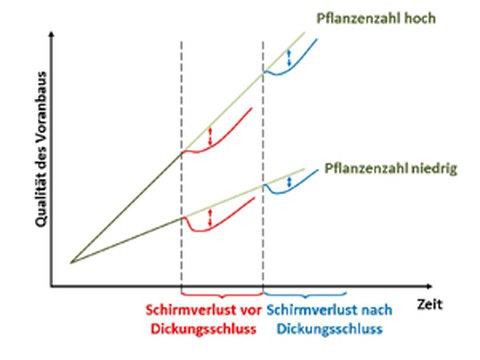Qualitative Entwicklung von Buchenvoranbau nach frühzeitigem Schirmverlust in Abhängigkeit von Standraum und Entwicklungsstadium
Im Projekt soll die Wirkung eines frühzeitigen Schirmverlustes auf die Qualität von Buchenvoranbauten untersucht werden. Für die qualitative Entwicklung von Voranbauten ist neben der Überschirmung auch die Pflanzenzahl entscheidend (LEDER und WEIHS 2000; LEONHARDT und WAGNER 2006; RUMPF und PETERSEN 2008). Die erste zu untersuchende Arbeitshypothese lautet demzufolge:
Die qualitative Entwicklung des Buchenvoranbaus nach Schirmverlust ist von der Pflanzenzahl, bzw. dem Standraum pro Buche abhängig. Es ist zu erwarten, dass der Schirmverlust bei dicht begründeten Voranbauten (geringer Standraum je Buche) weniger negative Auswirkungen auf die Qualität hat, als bei weit begründeten (großer Standraum je Buche).
Weiterhin spielt auch der Zeitpunkt des Schirmverlustes über den Buchen eine Rolle für deren weiteren Werdegang. Vor allem der Grad des erreichten Bestandesschlusses ist bedeutend für die qualitative Differenzierung (z.B. natürliche Astreinigung) der Buchen (RUMPF und PETERSEN 2008). Von dieser Annahme wird die zweite zu untersuchende Hypothese abgeleitet:
Die qualitative Ausbildung der Buchenvoranbauten ist von der Entwicklungsphase dieser zum Zeitpunkt des Schirmverlustes abhängig. Es wird davon ausgegangen, dass Voranbauten welche zum Zeitpunkt des Schirmverlustes das Dickungsstadium noch nicht erreicht hatten, eine geringere Qualität aufweisen, als solche bei denen der Bestandesschluss schon eingetreten war.
Abbildung 1 zeigt einen möglichen Gang der Qualität mit der Standzeit des Voranbaus, wobei die gewünschte Entwicklung (ohne Schirmverlust) bei verschiedenen Pflanzendichten durch die olivgrünen Geraden angezeigt wird. Die roten Kurven zeigen denkbare Entwicklungstendenzen der Qualität bei Schirmverlust vor Dickungsschluss in Abhängigkeit von der Pflanzendichte je ha. Blau dargestellt ist in gleicher Weise der Werdegang bei Schirmverlust nach Dickungsschluss. Differenziert nach den dargestellten Einflussfaktoren soll durch die Untersuchung die Frage geklärt werden, wie Buchen mit Schattenhabitus auf eine plötzliche Freistellung reagieren und wie sich dies in der Qualität wiederspiegelt. Anhand der Ergebnisse sollen umsetzungsorientierte, differenzierte Entscheidungshilfen und Behandlungsempfehlungen abgeleitet werden, in welcher Weise mit Buchenvoranbauten verschiedener Entwicklungsstufen und Pflanzendichten auf Kalamitätsflächen umgegangen werden sollte. Die Untersuchung soll zudem helfen, für zukünftig zu begründende Voranbauten Pflanzendichten herzuleiten, welche ein erhöhtes Sturmrisiko der Schirme berücksichtigen, um auf diesem Wege das Vorsorgeprinzip anzuwenden.

